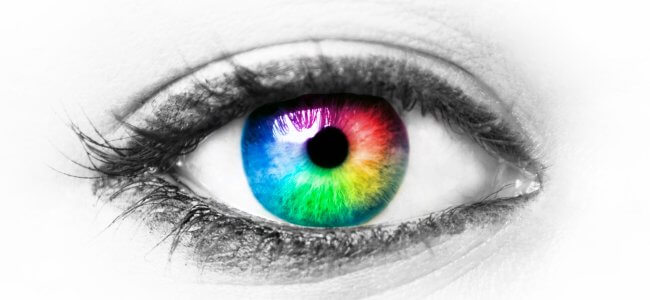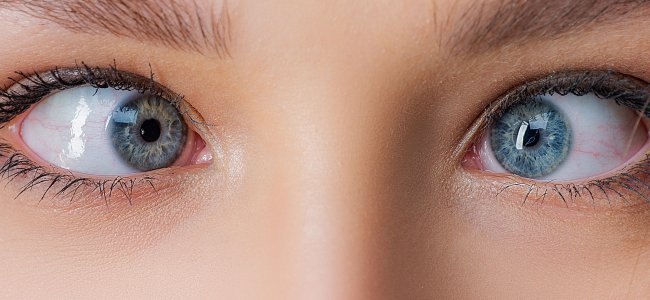Macular edema: blurred vision and colour alteration

The editorial staff of Emianopsia has the pleasure of hosting Dr Chiara Spatafora: graduated in Orthoptics and Ophthalmological Assistance with additional qualification in optics. Dr Spatafora proposes a study that focuses on macular edema.
Macular edema: what does it entail?
It corresponds to the discharge of fluid within the central region of the posterior pole of the retina, that is, the macula. The retina is a complex structure, consisting of as many as 10 layers, with well distinct anatomical and physiological characteristics. The macula is particularly important because it contains photoreceptors assigned to the vision of the colours (cones).
For this reason, this is the area in which the retinal image is formed, and visual acuity relies on its integrity. The macula has no vascularity, the presence of vessels may impair the functionality of the photoreceptors. Macular edema is caused by the accumulation of fluid caused by the rupture of the blood-retinal barrier (RBR). This barrier acts as a filter for the passage of molecules between the vascular structures and the retinal portion, it is internally formed by the endothelium of the retinal vessels and an external layer of pigmented epithelium.
What are the symptoms?
The presence of the liquid causes a thickening of the macula and the majority of symptoms reported by patients are: blurred vision, colour alteration, image deformation (metamorphopsia) as well as loss of sight with the onset of a central scotoma.
This disease of the eye does not, however, cause pain, and rarely manifests itself with myosapsias and photopsias (so-called “flashes of light”).
Causes of squint
This problem can arise from multiple pathologies: the vast majority are diabetes and age-related macular degeneration, but it can also be associated with retinitis pigmentosa and uveitis.
In the case of inflammatory macular edema, the causes are mainly uveitis, so the inflammation of the uvea often subject to frameworks of autoimmune systemic pathologies, or post-cataract surgery that may cause an alteration of the osmotic flow, compromising the blood-retinal barrier.
The most common eye diseases in Western society
Now let’s take a brief look at what are the most common eye diseases in the West.
Diabetic retinopathy
Diabetic retinopathy (RD) is manifested in about 30% of people suffering from diabetes: among the main risk factors are the duration of the disease and the lack of control of metabolic failure. The glycaemic changes, in addition to the increase in mean age, are causing serious changes in the microcirculation, which has a great impact, considering that eyes’ microcirculatory bed is the thinnest in our bodies.
At the etiological level, macular damage is caused by the release of the VEGF factor (vascular endothelial growth factor): a molecule that stimulates the synthesis of the vascular endothelium and therefore of all new vessels. This process leads to the formation of new capillaries that are extremely fragile: they easily break and are responsible, in turn, for haemorrhages that compromise the vision even more. For this reason, all people with diabetes ( both mellitus and secondary ) should undergo regular eye examinations.
Therapy
In the case of diabetic retinopathy, the treatment consists in injections of anti-VEFG, followed by active ingredients that can inhibit the formation of new vessels. One of the most common is the Ranibizumab. In the most severe forms of edema, the intravitreal dexamethasone implant is also used: these are corticosteroid with powerful anti-inflammatory action. However, the use of corticoids has diminished, since they could cause cataracts and increased eye pressure.
Age Related Macular Degeneration (DMLE)
Age-related macular degeneration is the first cause of blindness in people over 60 years old; many risk factors contribute to its occurrence: prolonged exposure to solar radiation, clear iris, hypertension, and genetic predisposition.
The pathology mainly affects females and, especially in the early stages, is rarely diagnosed due to a lack of symptoms. The late phase is more easily recognizable and presents as either atrophic or exudative:
- atrophic: more common and with a better prognosis.
- exudative (about 15-20% of cases): happens when new vessels form from the choroid that tend to break causing haemorrhages which subsequently undergo healing processes. This process causes metamorphopsia at first, that in turn causes irreversible loss of vision. Currently, intravitreal anti-VEFG injections or photodynamic therapy could be used as exudative form of therapy if the former does not respond effectively.
In some cases macular edema, especially when linked to chronic degenerative diseases or tumours, may lead to exudative retinal detachment, which requires timely surgery.
A peculiar form that involves, however, especially the male sex is the central serous chorioretinopathy: it is an accumulation of subretinal fluid that does not generally cause a large decrease in visual acuity, but above all metamorphopsia therefore deformed images, usually shrunken. The peculiarity of this disease is that it manifests itself due to strong stress and can resolve spontaneously.
Which exams are needed for the diagnosis?
In all forms of edema the diagnosis makes use of the same examinations:
- at the initial stage, an accurate history that collects all the symptoms reported by the patient and that allows to exclude pathologies that also involve the optic nerve;
- very important is the measurement of visual acuity both at a distance and at close range, even if in the initial phase it is not enough for the diagnosis because as already stated, the loss of visual acuity has not been suffered.
- on the other hand, a very useful test in the case of macular alteration is the Amsler test: a subjective, non-invasive test, which allows to very quickly assess the presence of metamorphopsia that can occur even at an early stage.
As for the objective tests we find instead:
- examination of the ocular fundus;;
- OCT: is a fundamental examination because it allows both a quantitative and qualitative analysis of the retinal layers, it is not invasive, it is painless and can be done both in myosis and in mydriasis, although the latter is preferable. In case of edema the increase in thickness and the lifting of the retinal layer involved can be easily observed. The OCT must be repeated over time because it takes on an important significance not only in the diagnosis, but also in the follow-up of the disease and allows to understand if the prescribed therapy has been effective;
- the visual field: is an examination carried out always in myosis and used to assess the presence of scotomas ( that is, the areas in which visual perception has been lost due to photoreceptor damage).
- fluoroangiography: is the most invasive test involving the injection of a dye, usually fluorescein, into the forearm. The dye highlights two different circles that retinal and that choroidal so to allow the observation of the physiological retinal perfusion or of its possible alterations in the vascularization. In case of edema, we will have a hyper-fluorescence due to an accumulation of the dye in the fluid.
We thank Dr Spatafora for this study on macular edema and invite you to read her article Keratoconus: how to recognize symptoms and causes.

You are free to reproduce this article but you must cite: emianopsia.com, title and link.
You may not use the material for commercial purposes or modify the article to create derivative works.
Read the full Creative Commons license terms at this page.









